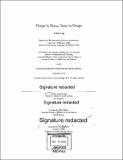| dc.contributor.advisor | Neri Oxman. | en_US |
| dc.contributor.author | Ling, Andrea Shin | en_US |
| dc.contributor.other | Program in Media Arts and Sciences (Massachusetts Institute of Technology) | en_US |
| dc.date.accessioned | 2019-03-01T19:59:10Z | |
| dc.date.available | 2019-03-01T19:59:10Z | |
| dc.date.copyright | 2018 | en_US |
| dc.date.issued | 2018 | en_US |
| dc.identifier.uri | http://hdl.handle.net/1721.1/120696 | |
| dc.description | Thesis: S.M., Massachusetts Institute of Technology, School of Architecture and Planning, Program in Media Arts and Sciences, 2018. | en_US |
| dc.description | Cataloged from PDF version of thesis. | en_US |
| dc.description | Includes bibliographical references (pages 136-139). | en_US |
| dc.description.abstract | THE USE of biological agents, such as bacteria, fungi, plant material, and insects, is proposed as a viable design methodology that can include end-of-life material treatment and re-use as part of the design process. Decay, typically thought of as a destructive process with spatially and temporally unpredictable results can be potentially designed to high levels of spatial and temporal tunability, such that the product of decay can still be of value to the designer. In particular, could microbes, in combination with water, be guided to selectively disintegrate, and potentially also then be harnessed as agents of assembly, enabling design construction instead of destruction? What would the ecology of this system that includes the microbes, biocompatible substrate, and contextual environment, look like? How might it behave and how might this affect how architects design the built environment? The main goal of this thesis is to understand how water-induced decay of biocomposite-based artifacts might be designed such that the deterioration process has use-value for the designed artifact and how this decay might be harnessed as a formative agent instead of only as a deconstructive one. This understanding will be informed by the execution and analysis of a series of case study projects that include: Aguahoja: Artifacts and Hexes Aguahoja: Colonization Aguahoja: Pavilion For these projects, water-based composites of chitosan, cellulose, and pectin, will be additively printed into architectural-scale artifacts and panels which are used as the skin of a small pavilion. The use of the chitin-cellulose-pectin composite introduces a water-dependent biocompatible material system that can act as the base scaffold for biofilms and microbial colonies. A series of material characterization tests were done to understand the nuances of the different bio-composites. Working challenges for this system included warping and uncontrolled deflections due to changing relative humidity and the gradual and constant dehydration of the material. This hydration dependent activity also dictated flexibility rigidity, and colour. Water is used to initiate the disintegration of the panels as well as initiate the growth of microbial cultures on the panels. The projects described here are intended to serve as examples of how a designer might be able to incorporate biological agency into her process. It is not intended as a comprehensive guidebook, but rather as case studies of how one might use nascent biological tools in current design methodology and how that methodology might have to change in order to leverage biology in her process. | en_US |
| dc.description.statementofresponsibility | by Andrea Ling. | en_US |
| dc.format.extent | 139 pages | en_US |
| dc.language.iso | eng | en_US |
| dc.publisher | Massachusetts Institute of Technology | en_US |
| dc.rights | MIT theses are protected by copyright. They may be viewed, downloaded, or printed from this source but further reproduction or distribution in any format is prohibited without written permission. | en_US |
| dc.rights.uri | http://dspace.mit.edu/handle/1721.1/7582 | en_US |
| dc.subject | Program in Media Arts and Sciences () | en_US |
| dc.title | Design by decay, decay by design | en_US |
| dc.title.alternative | Decay by design | en_US |
| dc.type | Thesis | en_US |
| dc.description.degree | S.M. | en_US |
| dc.contributor.department | Program in Media Arts and Sciences (Massachusetts Institute of Technology) | en_US |
| dc.identifier.oclc | 1088722797 | en_US |
